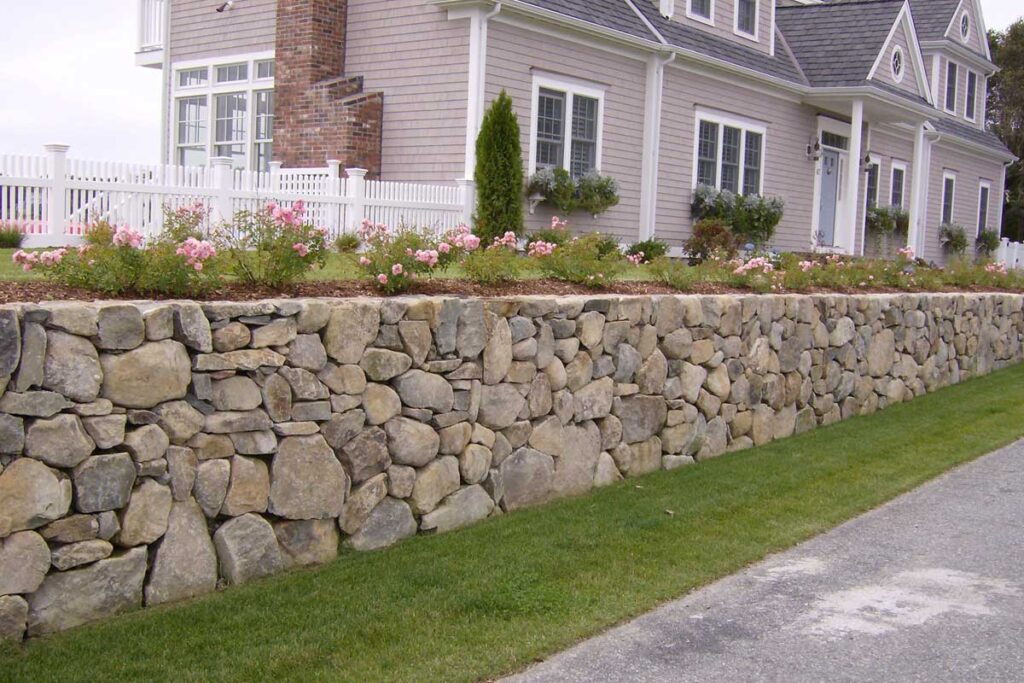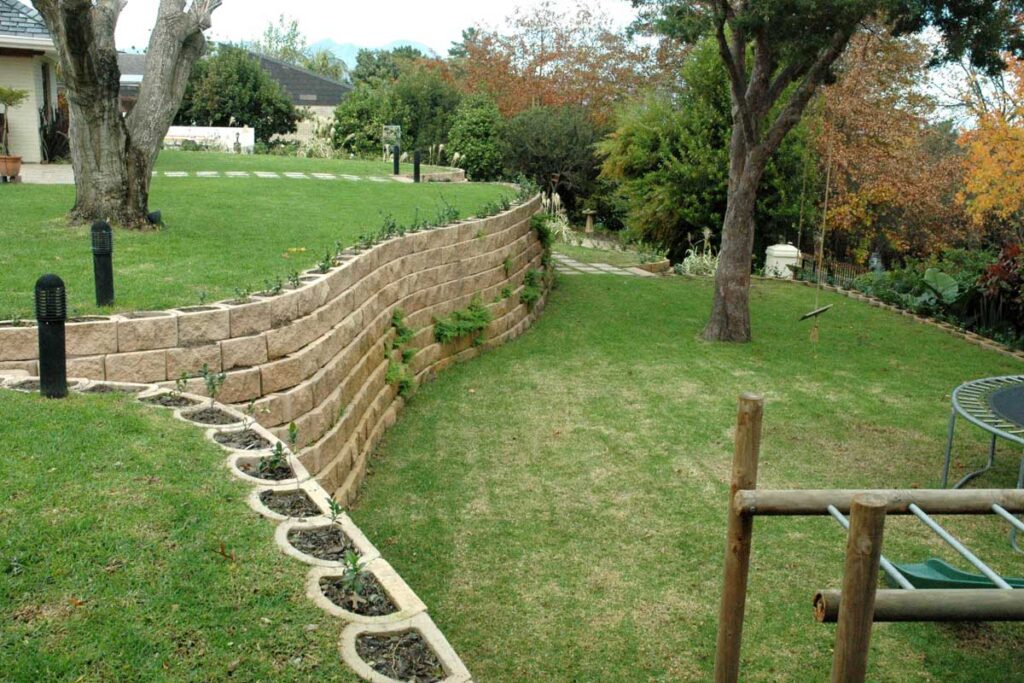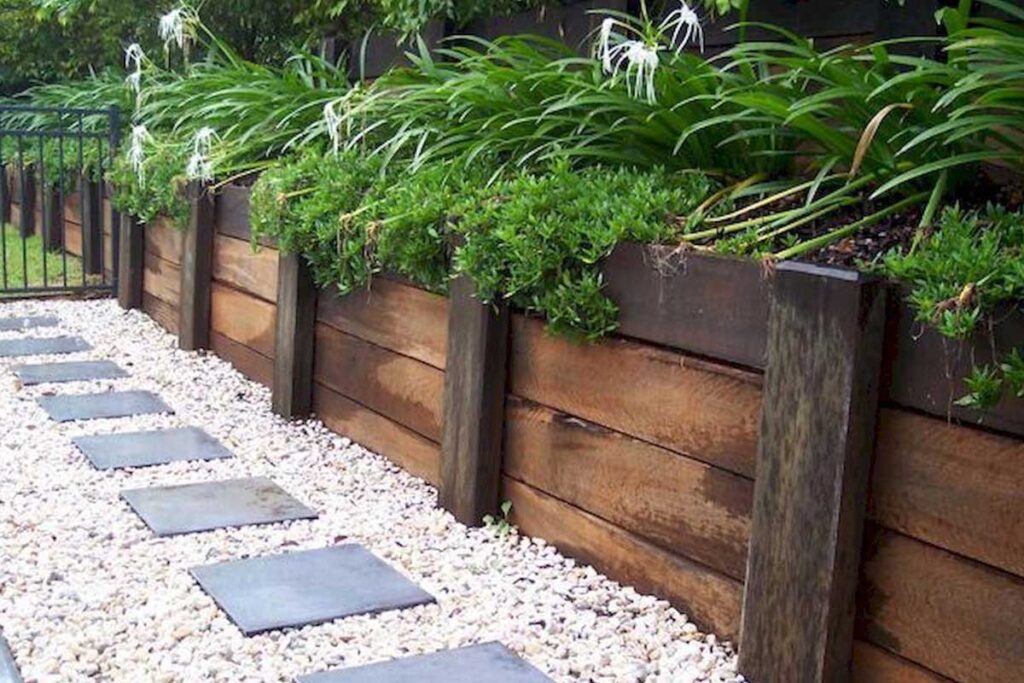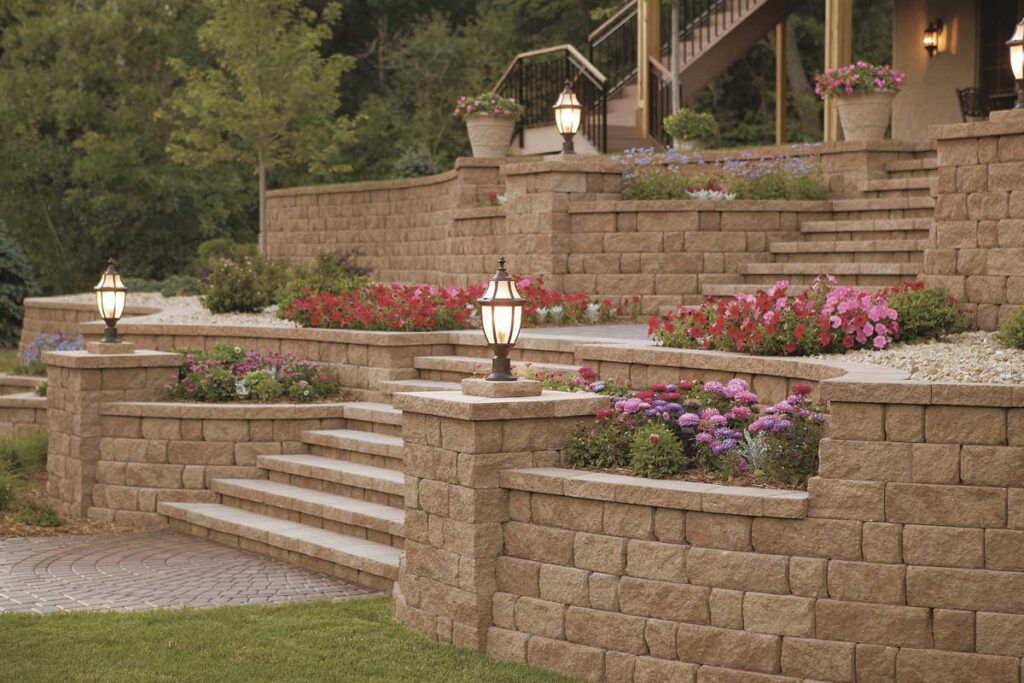Retaining Wall Construction
Whether you decide to construct your retaining wall out of block, brick, stone, wood, or concrete, the objective should be to blend the retaining wall into your environment. A sloping lawn should never have an angle greater than 45 degrees, and the softer the slope, the better. The slope will be milder the higher the wall.
Check your local building codes after determining the height of the walls. Before a wall taller than 3 feet may be constructed, many towns demand both a building permit and an engineer’s approval. To build a robust, long-lasting wall for taller constructions, meticulous engineering is necessary.
There are various reasons why you might want to construct a retaining wall, including:
- Halting or reducing erosion
- Aesthetics view
- Minimizing flooding
- Water management
- Expanding your yard’s available space
- Avoiding sink holes and stagnant water
- Legal obligations
Block Segmentation Systems
The range of segmental systems using interlocking blocks that don’t require mortar demonstrate the most recent advancements in retaining walls. With the aid of these systems, you can complete a job that will appear intricate and expert. The simplest DIY methods use blocks with a lip on the lower, back edge that ties them together for a stepped effect and are best for small walls (about 3 feet high). The pressure that results from the forward movement of the blocks when the space behind the wall is filled with earth strengthens the joints between the lips and the blocks below.
Alternative systems provide various interlocking properties. Some blocks join via a cast tongue and groove. To provide accurate alignment and a solid mechanical connection between the courses, some systems use fiberglass pins that are inserted between the blocks. Some of the stones have hollow interiors that, when filled with gravel, form an interconnecting, semi-solid web of rock across the wall. Moreover, many systems demand that reinforcement mesh be laid in between block courses.
Any wall that is taller than four feet should be properly built before it is installed to ensure the maximum strength. You need to think about drainage, structural strengthening, and the stability of the wall as a whole. Each tall wall design ought to have the courses positioned apart to create a “battering” impression. The wall slopes backwards as it becomes taller, to put it another way. A wall may eventually lean forward due to the weight of the ground behind it, yet this hammering impact gives it more life. Although battering is one way to make a wall stronger, the majority of segmental systems combine this strategy with the other reinforcing techniques discussed above that are reinforcement grids, steel reinforcement, or anchors.
When lateral pressure is taken into account, both the possibilities for reinforcing and the design of very tall walls become somewhat complicated. For instance, a retaining wall that is 8 feet tall is not merely twice as powerful as one that is only 4 feet tall. In reality, the 8-foot wall requires four times more strength. It would be wise to get a certified engineer to create a design for walls taller than 4 feet. Keep in mind to at the very least strictly adhere to the manufacturer’s directions. Also keep in mind that hauling truckloads of gravel, hefty block, and dirt are required while creating large walls.

Cement Walls
Although a concrete retaining wall might not be as beginner-friendly for the first-time do-it-yourselfer, it can nevertheless offer the greatest level of defense against drainage and erosion issues for any property. Unlike to walls made of brick or stone, those made of concrete do not need additional reinforcement, according to Nachman Pool Company specialists, because the base’s width and the wall’s weight give sufficient structural support.
Building a solid, precise shape is the most crucial stage in creating a stable, appealing concrete wall. Any breakdown in the wall forms would be fatal because of the heavy strain that the wet concrete would impose. A straight wall type is built using external grade plywood sheathing that is 1/2 inch, 5/8 inch, or 3/4 inch thick, as well as studs, spacers, ties, and walls. Sheathing creates the mold, whereas studs provide support and stability.
Before the pour, spacers are put in place to keep the spacing equal and support the form. The concrete’s pressure is resisted by wire ties that secure the shape. Wales straighten the form and support the studs in forms that are taller than 4 or 5 feet. For the majority of forms, two horizontal walls are adequate, but they shouldn’t be placed more than 30 inches apart from one another. Casting the wall along with the footer is an option for shorter, lighter walls. For larger walls, the footer and wall must always be poured separately.
Before constructing a retaining wall, do not forget to consult an engineer
Even while a retaining wall for your backyard may seem like a straightforward solution, if you don’t do your homework, you could quickly find yourself in trouble. Before beginning the construction of your retaining wall, there are various reasons to speak with an engineering expert. Ask a licensed engineer for advice if you’re unsure. Before you start, you should verify your local construction codes to discover if and when they call for a building permit. If you don’t, your city may issue a stop work order, penalize you, and maybe place liens on your home. Also, you should inquire about the prerequisites for permission from your homeowner’s association.
In accordance with the International Building Code (IBC), “a building permit shall not be required for retaining walls that are not over 4 feet in height measured from the bottom of the footing to the top of the wall, unless supporting a surcharge.” This code has been adopted by numerous municipalities or modified by them. It is crucial to review the construction codes in your particular community. Let’s look more closely at the details of the code.
How tall is your wall?
The retaining wall begins from the bottom of the first block or bottom of the footing, contrary to the widespread notion that you should only think about what you can see when thinking about a retaining wall. For instance, a retaining wall with an exposed height of less than 3.5 feet will normally have at least 6 inches of embedment (hidden wall), giving it a total wall height of 4 feet.
For cantilever or segmental gravity (block) retaining walls, a construction permit is normally necessary if the total height of the wall (exposed and buried) exceeds 4 feet. Even though there is no premium, some towns demand a building permit for walls taller than two feet. At wall heights between 4 and 6 feet, some localities will issue a building permit without an engineer’s signature. It is crucial to confirm your local laws once more.
Many block makers also impose their own height limitations. The maximum height constraints for a particular block system will typically range from 2 to 6 feet. You should not raise a block above the height advised by the manufacturer. Consult the block supplier or an expert to confirm the maximum height for that block system if you plan to construct a wall taller than 2 feet. Nachman Pool Company is at your service and our experts will happily answer your questions.

Do you have to pay a surcharge?
Anything that might exert a lateral stress on the wall is considered a surcharge. An engineer must assess any surcharge on the wall. This includes things like cars, a pool, machinery (like an air handler or a pool pump), footings from a building (like your house or porch), or even just a fence on top of the wall. Even though it is not attached to the wall itself, a fence nonetheless places a wind strain on the wall. Additionally, when trees swell and gain weight, they will place a surcharge behind the wall, cause the wall’s face to protrude due to their roots, and place wind loads on the wall due to their height. Beyond the wall, small plants and shrubs are permissible.
In general, any surcharge object’s edge must be at least twice as far away from the retaining wall’s back as the height of the entire wall. This means that if your wall has a total height of 4 feet (buried height + exposed height), the edge of any surcharge needs to be at least 8 feet away from the back of your wall.
Is there any water near your house?
Do not forget to contact an engineer if your wall will be built close to a pond, creek, or other water source, even if it is just temporary. Whether there are irrigation lines, water mains, or other sources of pressured water, they could pose a serious problem if they start to leak or explode. The most common reason for retaining wall failures is water, so numerous additional precautions must be taken to guarantee you have a safe wall. For increased safety, you should think about moving or piping any downspouts away from your wall while creating your site plan. Water should never drain into a wall but always away from it. You should make sure that water does not collect behind a wall. Don’t hesitate to call an engineer if the water cannot be diverted away from the wall. Get in touch with an engineer if the area where your wall will be built has any underground water or is always wet.
Are You Near a Seismic Area?
An engineer should examine each retaining wall in a seismic zone. Go to the United States Geological Service’s (USGS) map to see whether you are in a seismic area. An engineer needs to analyze areas that range from yellow to dark red.
Is There a Pathway Near Your Wall?
The proximity of your retaining wall to a walkway is another factor to take into account. The vertical drop (or exposed height of your retaining wall) must be greater than 2.5 feet for a handrail to be required by building rules, and the pathway must be within 3 feet of the vertical drop. If the retaining wall is taller than 6 feet, a fence or handrail is always necessary unless there is another way to keep people from climbing the wall. Please ask an engineer if you have any questions regarding whether your wall needs a fence or guardrail. If someone were to fall off the edge of your wall, this could be a tremendous liability for you.
Retaining wall construction guidelines with additional factors
For retaining walls that stretch over four feet, design and construction are the most crucial factors to take into account. There are many different sorts of designs available, but it is essential to speak with a qualified engineer who has experience in your particular area in order to come up with a design that matches it. The following categories of retaining wall designs are often ones that specialists are familiar with:
In order to endure the pressure of the earth and/or water, a gravity wall relies on its own weight.
A cantilever wall has a soil-retaining concrete footing. The same soil that is seeking to fall the wall balances the back of the footing.
A cantilever wall and a counterfort wall are similar, but a counterfort wall has a tee section that is perpendicular to the main wall. The tee part effectively functions as a beam as a result.
The tee section of a buttress wall is located in its front, where it serves as the wall’s main support system.
For walls exceeding four feet, it is advisable to leave building to the experts as each landscape will demand a different design.
Construction of the base properly is important since it can affect the way your retaining wall looks, the type of soil it is built on, and how well it drains. The pertinent elements, such as soil displacement, soil type, annual rainfall, and nearby structures, must be taken into consideration. Failing to do so may result in a retaining wall that slips down a hillside with the first significant flash flood rain rather than standing the test of time which is a terrible mistake.

Some Other Factors That You Should Consider
Other things to consider include the retaining wall’s intended use, flood risk assessments, and environmental considerations.
Retaining walls can give you and your loved ones years of delight if they are done correctly. Check out the Heritage Block retaining wall installation instructions if it would be more convenient for you.
Do not hesitate to consult the professionals at Nachman Construction Company regarding building retaining walls and other renovation ideas. We are always at your service and happy to come up with customized plans for your specific renovation ideas.



